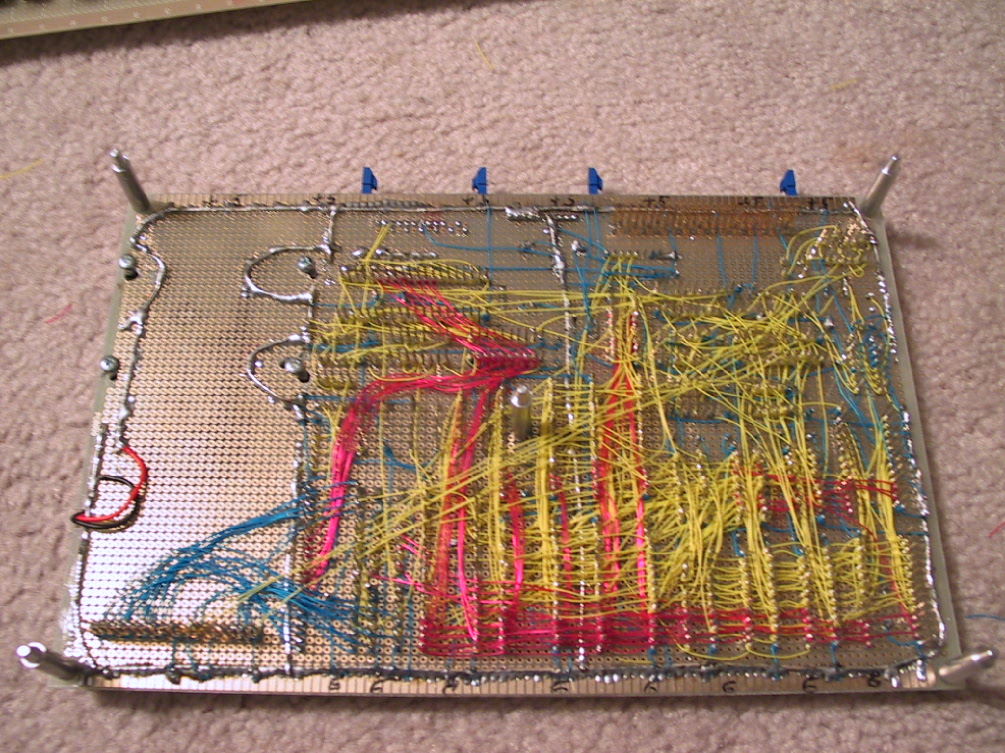
PDP-8/sl
A DEC PDP-8 Clone

PDP-8/sl
A DEC PDP-8 Clone
New, Desktop Model
This computer is a nearly exact logical duplication of a Digital Equipment Corporation PDP-8/e of the 1970's. The
PDP-8, originally sold in 1965, was a tremendously influential computer of the 60's and early 1970's; it is arguably
the spiritual ancestor of the personal computer, being the first truly mass produced general purpose computer.
Gordon Bell designed it (according to some sources, but strangely, Mr. Bell apparently looks at the PDP-8 as an
outgrowth of earlier equipment, which he definitely did design). He mentioned that it was inspired by an idea from
Seymour Cray, then a young designer at Control Data Corporation. Click here for a picture of an original PDP-8
with the covers off.
Although originally five figures worth of 1960's dollars for a complete running system, it was a great deal at
the time, because large computers - and this is essentially the only kind one could acquire until the birth of
DEC - could run into 6 or 7 figures, again, in 1960's dollars. The word "computer" was so scary back
then that DEC was not enthused about calling the PDP-8 a computer - "PDP" stands for "Programmed
Data Processor". The machine had a now quite strange 12-bit word and originally up to 4 KW (four thousand
12-bit words) of memory, later increasing to 32+32 KW with additional hardware, some of which helped to support
timesharing. When the first model was built, there were almost no integrated circuits or RAM chips - the computer
was built with discrete transistors and magnetic core memory. The OS8 manual I use for this machine still refers
to core memory and lamps on the front panel. One of the shortcomings of the PDP-8 architecture is its inability
to easily deal with read-only-memory - but when the computer's main memory consisted entirely of magnetic core,
this didn't matter!
Incredibly bad business decisions caused DEC to lose a golden opportunity, its market share, and ultimately, its
very existence. In the mid-1970's, Intersil designed a PDP-8 on a chip (with the apparent blessings of Digital),
the IM6100, and sold it at a reasonable price. The PDP-8 was certainly not a state of the art minicomputer by then
but they were still sold and used worldwide. One of the weaknesses of early microcomputers was the lack of software
to run on them. Having an inexpensive PDP-8 on a chip opened the door to a decent disk operating system, dozens
of major tools and hundreds of applications that DEC and others had produced. Unfortunately, Intersil didn't do
a good job on making it completely compatible or easy to use, and DEC didn't lower its software pricing (thousands
of dollars) to OS8 and tools to match the price of the hardware, so the chip was pretty much a flop. Imagine paying
$5,000 of today's dollars for a single copy of Windows XP for your home computer. Soon thereafter, more modern
microcomputers had more modern software that far surpassed that of the PDP-8 at much more reasonable pricing levels,
and the window of opportunity was gone. They attempted to pit the PDP-8, too little, and too late, against microcomputers
in DECmate word processors, bundling a small single chip PDP-8, a terminal, and floppy drives in a rather expensive
box. By that time, CP/M or PC based word processors were better choices. DEC stayed with its low volume, high-profit
margin attitude to the bitter end when they were ignominiously absorbed by Compaq, who purchased them largely for
their customer base and significant technical infrastructure.
To this day (2002), there are still a few "real" PDP-8's in operation, running industrial equipment and
processes, particularly in third-world countries. I worked at an electronics company in the early 1990's where
the component stuffing machine in PCB manufacturing was controlled by an embedded PDP-8/m. The early models can
essentially be repaired ad infinitum if they are kept in good mechanical condition, because they use simple transistors,
or common TTL logic chips, not special integrated circuits that are difficult to find and will become impossible
to find in the future.
The PDP-8 and PDP-11 were often "cloned" by Iron Curtain countries in the 60's and 70s, and significant
additions and improvements were made to them.
The case in Figure 1 is a rackmount with the period-correct keylock and reset switch. LED's signal standby and power. The fake DEC logo's add a touch of realism, in my opinion. This machine most closely resembles the PDP-8/m, the industrial version of the PDP-8/e.

Figure 1. PDP-8/sl Playing BLKJAC.BAS

Figure 2. Inside View

Figure 3. Rear View of Board
The board (Figures 2 and 3) is a wire-wrapped version of the board/firmware developed by Robert Armstrong (see
www.sparetimegizmos.com). His BTS6120 is a very well designed project and it's too bad that the number of 6120
chips in the world is so small! He was instrumental in helping me through a significant number of problems, some
caused by wire-wrapping and noise, others caused by self-inflicted wounds - that is, miswiring. The worst problem
was a PPI chip that was too slow for proper hard disk operation. Wire wrapping something this complex with so many
interrelated systems is not for the beginner, and although I'm pretty good at this, I've never done it for 40 hours
a week. My board is slightly different electronically from the original BTS6120 design in the following ways:
1. More flexible data format selection for the 6402 to accommodate my peripherals
2. Different speeds on the RS-232, again, to accommodate my peripherals
3. Newer Dallas Semi 1321 BBRAM controller utilized (but you lose the battery RAM test function; I installed an LED in its place)
4. Reset from the 1321, not the Econoreset
5. R/W LED's on board.
6. 128Kx8 static RAM's used instead of 512's, for cost reasons.
7. EPROM socket supports only the first 8K of a 27128,256, or 512K EPROM.
8. 2.5" hard disk and BBRAM all on a single board
9. Shared RS-232 inputs to a single serial port, to accommodate a paper tape reader
10. Significant numbers of pullups and pulldowns to combat noise
Not having the FREAKING hundreds of dollars for a PAL/GAL programmer, I built one of this very clever design
Much more than an "emulation", this hand-wrapped board uses a second-generation Harris 6120 chip, which
was used by DECmate word processing workstations in the early 80's, at the end of the PDP-8's long reign. What
permits this board to be so tiny, is the amazing gate arrays developed by Mr. Armstrong. These gate arrays perform
I/O functions better than the chips from Harris and random TTL, in that they permit the board to run true early
1970's OS8 as one would find on a real PDP-8, as opposed to OS/78, which was apparently a hacked up version designed
to run only on the VT-78 and the DECmates. The programmable logic parts replace many chips, as do the CMOS RAM
chips, which replace the pizza-box size stacks of hand-strung magnetic core memory, which cost thousands of 1960's
dollars. The notebook drive on board replaces the deep four-figure hard disk drives used 30 years ago. Nonetheless,
this computer operates at an instruction level just like those file-cabinet sized components did. The board also
has 512K of battery backed RAMdisk; each logical 128K drive is almost as big as the original 8" floppy implementations..
I may, in the future, execute a true front panel emulation with examine/deposit, etc.
If you think DOS, or for that matter, CP/M were hard to work with, you should work with OS8 for a while. It is
amazing, though, that it does what it does with only 32KW of RAM. It even has user-installable device drivers linkable
by the user into the system! This is how Mr. Armstrong got the RAMDISK and IDE drives to be legitimate PDP-8 system
devices.
OS8 (or OS/8, depending on what you read) supported several languages such as FORTRAN, FOCAL, BASIC, and also included
an assembler. FOCAL is a BASIC-like interpreter with unusual features. The version that I have runs from paper
tape and was written in 1969.
Yes, 1969.
The BASIC is rather good, roughly comparable to Altair Extended Disk BASIC, permitting both string handling and
disk access. The FORTRAN compiler was not really up to FORTRAN 66 standards, but nonetheless amazing considering
the severe memory limitations of the PDP-8 (many PDP-8's had less than the full compliment of core RAM to work
with, because of the staggering cost). If you see the FOCAL language start up, and you are familiar with the Altair
8800, you will be certain that it was the inspiration for Bill Gates' 4K MITS BASIC.
The manuals for the PDP-8/e could fill an entire bookcase with no trouble. DEC would even sell the blueprints for
the machine.
Compaq (the owner of DEC) was very generous to make all of this software available for non-commercial use to hobbyists
and historians.
This machine will be a small wooden rack with my Decitek paper tape reader. Most of the time, a DEC VT-320 terminal
will used to communicate with it, although I also plan to use an early 1980's Panasonic thermal printing terminal.
The VT320 terminal is a late-80's dumb terminal, built near the end of the DEC era.
If you think that I was a wack job for building this, then you really need to see Mr. Armstrong's web site. His
"hobby" projects are of absolutely commercial quality.
I have a very limited number of spare parts to built more machines with; email me if you are seriously interested. Be aware that this is a massive and expensive undertaking to do "right".